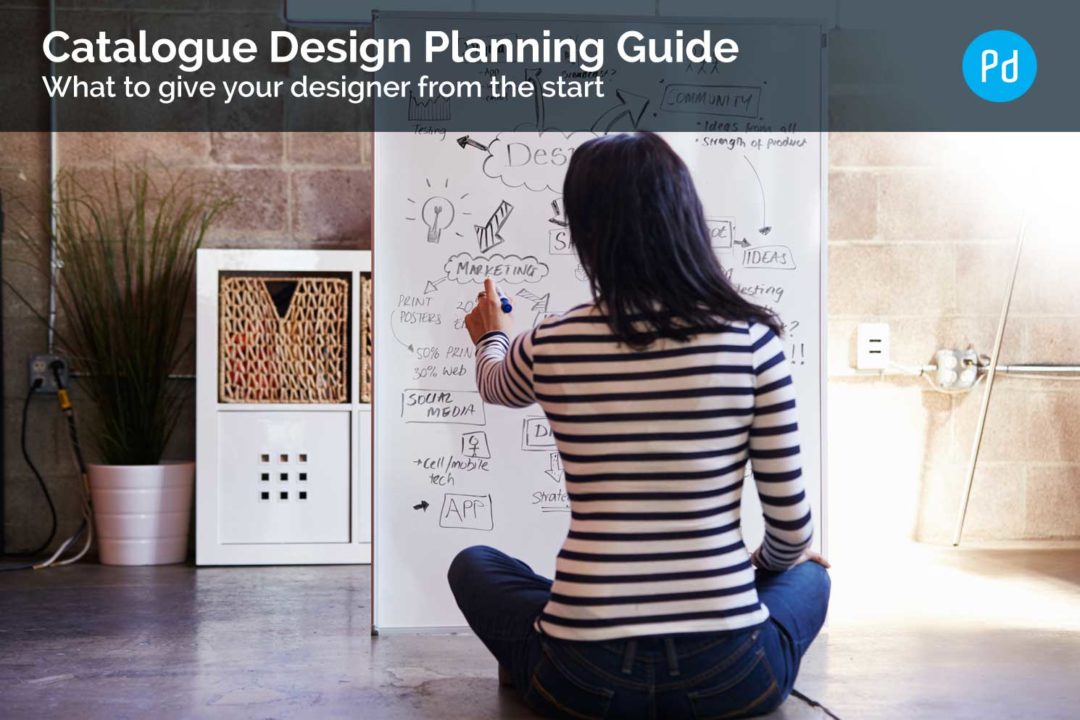If you are about to embark on producing your first product brochure this Catalogue Design Planning Guide will escort you through each and every step from start to finish. We explain exactly what to expect from your catalogue designer and the most important steps to consider that will make the whole process easy and trouble-free as possible for you.
Scheduling
Catalogue design planning starts with a realistic schedule for completion highlighting key delivery milestones. Work backwards from your delivery date, allowing sufficient time for all the separate stages.
Page Plan
Create a simple flat plan layout to map the structure and order of content throughout your catalogue pages. This is a flat page plan, not the final document. It’s a great starting point and will help you build the structure, particularly for a multi-page catalogue, work out the flow of information so you can see it all at a glance.
It may take a few attempts until you reach a point that you are satisfied with the structure and page order. Remember, this is a plan and you may need to adjust things as you go along. It is perfectly acceptable for the catalogue design planning phase to change as you go along.
Depending on the complexity or extent of your catalogue, you can either build your flat plan manually using pen and paper or use one of the great online tools available to create it much more effortlessly and quickly. Here are two we’ve tested that are very simple to use. They offer free trial periods (minimum 15 days) which is usually more than enough time to get this exercise completed. Try: www.magmanager.co.uk or www.blinkplan.com.
Briefing Your Designer
Once you have a flat page plan for your catalogue, write up a clear project design brief, giving both to your designer showing what is to be accomplished. Be sure to provide sufficient background information about your business, details of your closest competitors and more importantly a clear description of your target market.
Be clear at this early stage if you have any particular creative likes or dislikes, colour and style preferences or aversions. Your designer should ask these questions in advance. If you need help with preparing your design brief, please refer to our Free Design Brief Guide.
Design Costs
Thorough catalogue design planning also involves obtaining comparative cost proposals from at least two or three different designers giving them the same clear design brief. To help you choose the best designer or design agency compare the proposals very carefully. Don’t let the price alone be the basis for your decision. Who has understood your requirements the best? Look at evidence and samples of other design projects the designers have worked on showing their creative ability and track record.
You should expect to see a full breakdown detailing the creative and artwork processes they go through and what you will expect to receive from your designer as a result of their work. What guarantees are in place if you’re not happy with the design solutions presented? Look out for any hidden costs and question anything you are not sure about. The last thing you want is any unapproved charges at the end. Read more about what to look out for when choosing a designer.
Most designers or design agencies will be able to provide quotations for print production too, based on an agreed quantity, specification and project scope. This is particularly worthwhile as they will be able to recommend the most cost effective options to suit your requirements. This will save you the headache of dealing with printers directly plus all the unfamiliar terms and technical language they use.
Print Production Costs
Designers often have very good working relationships with reliable, high quality printers that offer them very competitive prices. Also, conscientious designers with particular pride in their work will oversee the production process to help avoid any problems along the way.
If you have to adjust the scope of your catalogue in any way check with your designer how this will affect costs. Both design fees and print production prices could well be affected.
With the design brief and costs agreed you should now be ready to give your designer the thumbs-up to proceed with initial design concepts and layout ideas.
Need more help with your catalogue?
Here are a few more related, very useful articles which are a must read…
Catalogue Design Content Generation Guide
Catalogue Design Concepts – What to Expect From Your Designer
Artwork and Proofing Guide for Designing Catalogues
Remember to download our free guide for step-by-step tips and advice on creating the perfect brief for your designer.
Want to find out more about the services we offer at Palmiero Design? Feel free to get in touch or request a quote. We look forward to hearing from you!



